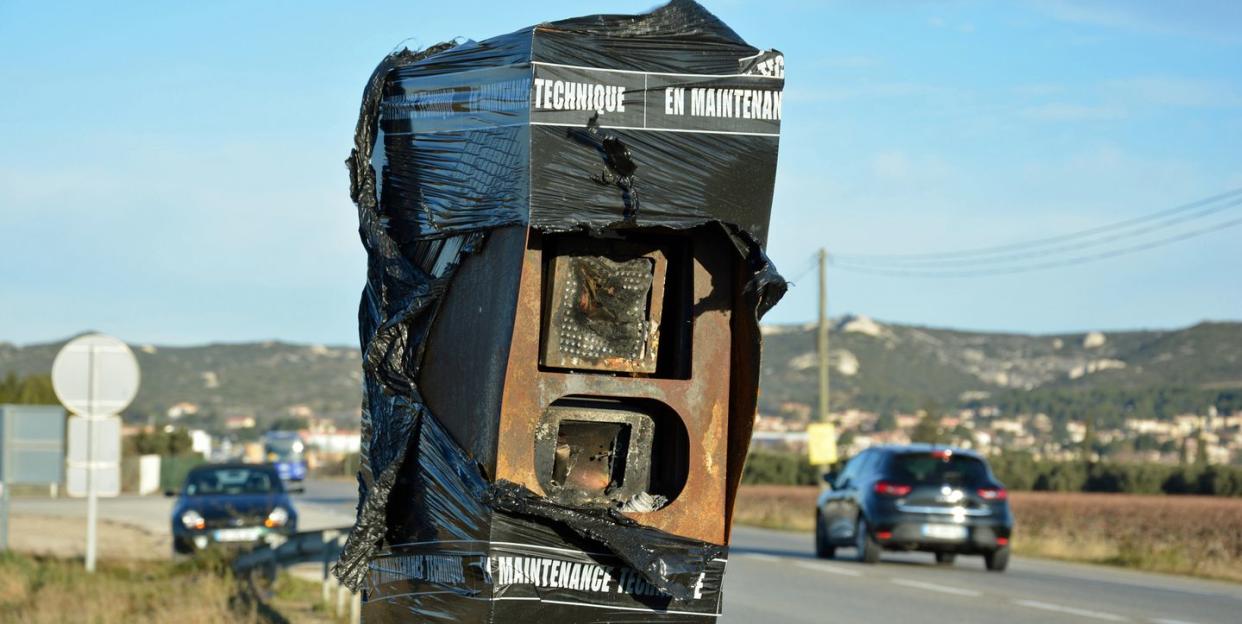French Protesters Have Deliberately Trashed More Than Half of Their Traffic Cameras

American news watchers may have nearly forgotten last fall's stories about the thousands of protesters taking to French streets. They are known as Gilets Jaunes for the bright-yellow safety vests they wear while protesting the country's sharply increased gas taxes. It's true that the level of chaos observed in the streets of downtown Paris has dropped by several notches since late last fall's peak. But not only does the the conflict opposing French motorists and their government rage on, it has moved into new terrain: sabotaging traffic cameras.
More than 60 percent of France's approximately 3200 traffic cameras, intended to monitor speeding and issue tickets 24 hours a day, have been vandalized or completely destroyed by Gilets Jaunes protesters.
Traffic cameras, it turns out, are an easy symbolic target for the Gilets Jaunes. Their movement started in November 2018 over fuel prices, as we've previously described. But the list of grievances they dramatically posted on French president Emmanuel Macron’s door also included one criticizing the proliferation of cameras on French roads and the reduced speed limits. Many motorists in France doggedly believe the government orchestrated these measures strictly to fill its coffers. Attacking speed cameras, the protesters rationalize, will hit the government where it hurts without negatively affecting motorists or private businesses.
There are several types of traffic cameras planted on the side of French roads-and protesters have demonstrated that there are several ways to destroy them. Some settle for taping a garbage bag or a yellow vest around the camera. Others spray-paint the front of the device. In more extreme cases, protesters set the camera on fire, usually by placing a tractor or a truck tire around the base of it, dousing it in a flammable liquid, and setting it alight.
Many drivers are probably breathing a sigh of relief as they freely explore the upper echelons of their car’s rev range. But the government and the Gilets Jaunes movement’s critics point out that traffic cameras aren't just repressive; they also play a significant role in reducing accidents and fatalities.
"I've seen imbeciles posting photos of themselves next to destroyed traffic cameras on social media. I hope they never experience the harsh reality of a traffic fatality," said Christophe Castanet, France’s minister of the interior, during a speech given to the Gendarmerie earlier this month.
Predictably, Speeding Is Up 20 Percent
Fire usually renders a traffic camera completely inoperative. Some of the ones used as a blank canvas for graffiti are still capable of monitoring speed, but they can't issue a ticket because they’re not able to photograph the speeding car. Government statistics revealed a 20 percent increase in speeding across France during December 2018 as motorists happily took advantage of the largely camera-free roads. Getting drivers to lift their foot off the gas pedal is easier said than done, though.
French authorities began relying on cameras to issue speeding tickets in 2004. Law-enforcement officials occasionally pull motorists over as is done in the United States, but these fines represent a nominal percentage of the speeding tickets issued annually. The police and the Gendarmerie both lack the personnel, the equipment, and the resources to monitor France’s road network while the traffic cameras are offline.
It normally costs the equivalent of a few hundred dollars to fix damage caused by minor vandalism, but some estimates peg the cost of replacing a fully burned-out traffic camera as high as $114,000. The fines paid by speeding motorists, in theory, are supposed to fund the cost of repairing or replacing the approximately 2000 out-of-commission cameras across the country.
French authorities already have a solution to the problem. They began testing a new, more advanced type of camera that’s allegedly more difficult to destroy because it’s placed 13 feet off the ground. Up to 6000 of these units will report for duty along French roads by 2020, and we suspect many will replace older cameras destroyed by the Gilets Jaunes.
('You Might Also Like',)

